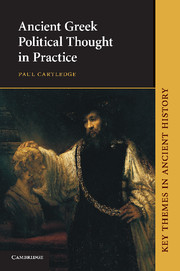Book contents
- Frontmatter
- Contents
- Preface
- Acknowledgements
- Timeline
- CHAPTERS AND NARRATIVES
- 1 Meaning in context: how to write a history of Greek political thought
- 2 The Greek invention of the polis, of politics and of the political
- Narrative I The prehistoric and protohistoric Greek world, c. 1300–750 BCE
- Narrative II The archaic Greek world, c. 750–500 BCE
- Narrative III The classical Greek world I, c. 500–400 BCE
- Narrative IV The classical Greek world II, c. 400–300 BCE
- Narrative V The Hellenistic Greek world, c. 300–30 BCE
- Narrative VI ‘Graecia capta’ (‘Greece conquered’), c. 146 BCE – CE 120
- APPENDIX I Selected texts and documents
- APPENDIX II The ‘Old Oligarch’: a close reading
- Bibliographical essay
- References
- Index
Narrative I - The prehistoric and protohistoric Greek world, c. 1300–750 BCE
Published online by Cambridge University Press: 05 June 2012
- Frontmatter
- Contents
- Preface
- Acknowledgements
- Timeline
- CHAPTERS AND NARRATIVES
- 1 Meaning in context: how to write a history of Greek political thought
- 2 The Greek invention of the polis, of politics and of the political
- Narrative I The prehistoric and protohistoric Greek world, c. 1300–750 BCE
- Narrative II The archaic Greek world, c. 750–500 BCE
- Narrative III The classical Greek world I, c. 500–400 BCE
- Narrative IV The classical Greek world II, c. 400–300 BCE
- Narrative V The Hellenistic Greek world, c. 300–30 BCE
- Narrative VI ‘Graecia capta’ (‘Greece conquered’), c. 146 BCE – CE 120
- APPENDIX I Selected texts and documents
- APPENDIX II The ‘Old Oligarch’: a close reading
- Bibliographical essay
- References
- Index
Summary
Between the world of the prehistoric Mycenaean Greek palace and the world of the historical Greek polis there was a gulf fixed. That makes a convenient aphorism, no doubt, but nevertheless it is a tellingly accurate distinction too. Strictly, the world of Mycenaean or Late Bronze Age Greece (c. 1600–1100 bce) was protohistoric rather than prehistoric, in that it was an age that possessed a form of literacy dedicated to the keeping of records. That literacy was of a special or restricted kind, however, practised only by skilled record-keeping scribes who were familiar with the 200 or so signs and pictograms devised to transcribe an early form of the Greek language. What the scribes recorded were interminable lists of people and things on a short-term basis; it was only an accident of destruction by (presumably hostile) fire that transformed the temporary clay tablets on which the ‘Linear B’ script was deployed into permanently legible baked artefacts.
The masters whom the scribes and their script served were sole rulers who called themselves high kings and lorded it over kingdoms of varying size, shape and power – from Thessaly in the north of mainland Greece to the island of Crete in the south-eastern Mediterranean, midway between Europe and Africa. We call the culture and period ‘Mycenaean’ because Mycenae in north-east Peloponnese was archaeologically the richest and most powerfully defended of these central sites, and because in the West's earliest literary fiction, the Iliad, it takes pride of place as the seat of great King Agamemnon, the overall leader of a united Hellenic expedition against Troy.
- Type
- Chapter
- Information
- Ancient Greek Political Thought in Practice , pp. 25 - 28Publisher: Cambridge University PressPrint publication year: 2009



